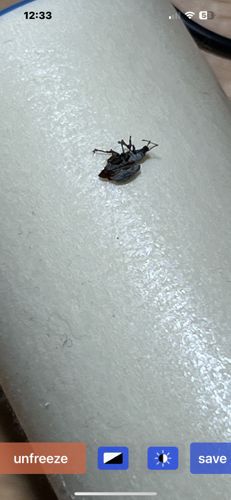Weevil
Scientific Name: Curculionidae (general, specific species cannot be determined from image)
Order & Family: Order: Coleoptera, Family: Curculionidae
Size: Typically 3 mm to over 10 mm, though some species can be larger.

Natural Habitat
Highly varied depending on species; can be found in fields, forests, gardens, stored food products, and homes.
Diet & Feeding
Mostly herbivorous, feeding on various plant parts including leaves, stems, roots, seeds, and fruits. Some species are serious agricultural pests.
Behavior Patterns
Many weevil species are known for playing dead or dropping from plants when disturbed. They have a characteristic elongated snout (rostrum) with chewing mouthparts at the end. Their life cycle typically involves egg, larva, pupa, and adult stages, with larvae often feeding inside plant tissues.
Risks & Benefits
Risks include being significant agricultural and stored product pests, causing damage to crops (e.g., cotton, maize, wheat) and stored grains. Some species can infest homes, seeking shelter. Benefits can include acting as biological control agents against invasive weeds (e.g., some thistle weevils).
Identified on: 9/24/2025